Project details
Skill
Cost
Estimated Time
Installing a stair runner can turn plain wooden stairs into an elegant focal point, providing cushion for your feet and reducing noise. With the right materials and tools, most homeowners can complete this task in a day. In the video above, we demonstrate the process of installing a striped cotton runner on a wooden staircase.
What Are Stair Runners?
Stair runners are narrow carpeting strips that cover a staircase’s center, leaving some wood exposed on either side. They come in different materials, patterns, and colors, allowing you to customize your stairs to match your home’s decor.
Benefits of Stair Runners
Stair runners have many advantages, such as these:
- Added warmth and comfort underfoot
- Improved safety by providing stair traction
- Reduced footstep noise
- Wooden tread protection
Types of Stair Runners
When choosing a stair runner, consider these popular options:
- Cotton: Soft, breathable, and available in different patterns
- Sisal or jute: Eco-friendly and adds texture
- Synthetic fibers: Durable and easy to clean
- Wool: Natural, luxurious, and long-lasting
Preparing for Stair Runner Installation
Before you begin installing, gather the following materials and tools.
Materials
- Carpet glue
- Carpet padding
- Double-sided carpet tape
- Stair runner carpet
- Staples (5/8-inch and 9/16-inch)
- Tackless strips
Tools
- Carpet knife
- Carpet tool
- Combination square
- Knee kicker
- Pencil
- Pneumatic stapler
- Rubber mallet
- Staple gun
- Tape measure
- Tin snips
Measuring and Planning
Accurate measurements are crucial for a successful installation. Here’s what to do:
- Measure the height of one riser and the depth of one tread.
- Add these measurements together and multiply by the number of stairs.
- Add an extra 12 inches to make sure you have enough material.
- Choose a runner width that allows for even reveals on both sides of the stairs.
- They come in different lengths, so you may need to mix and match.
Installing Carpet Runner on Stairs Overview
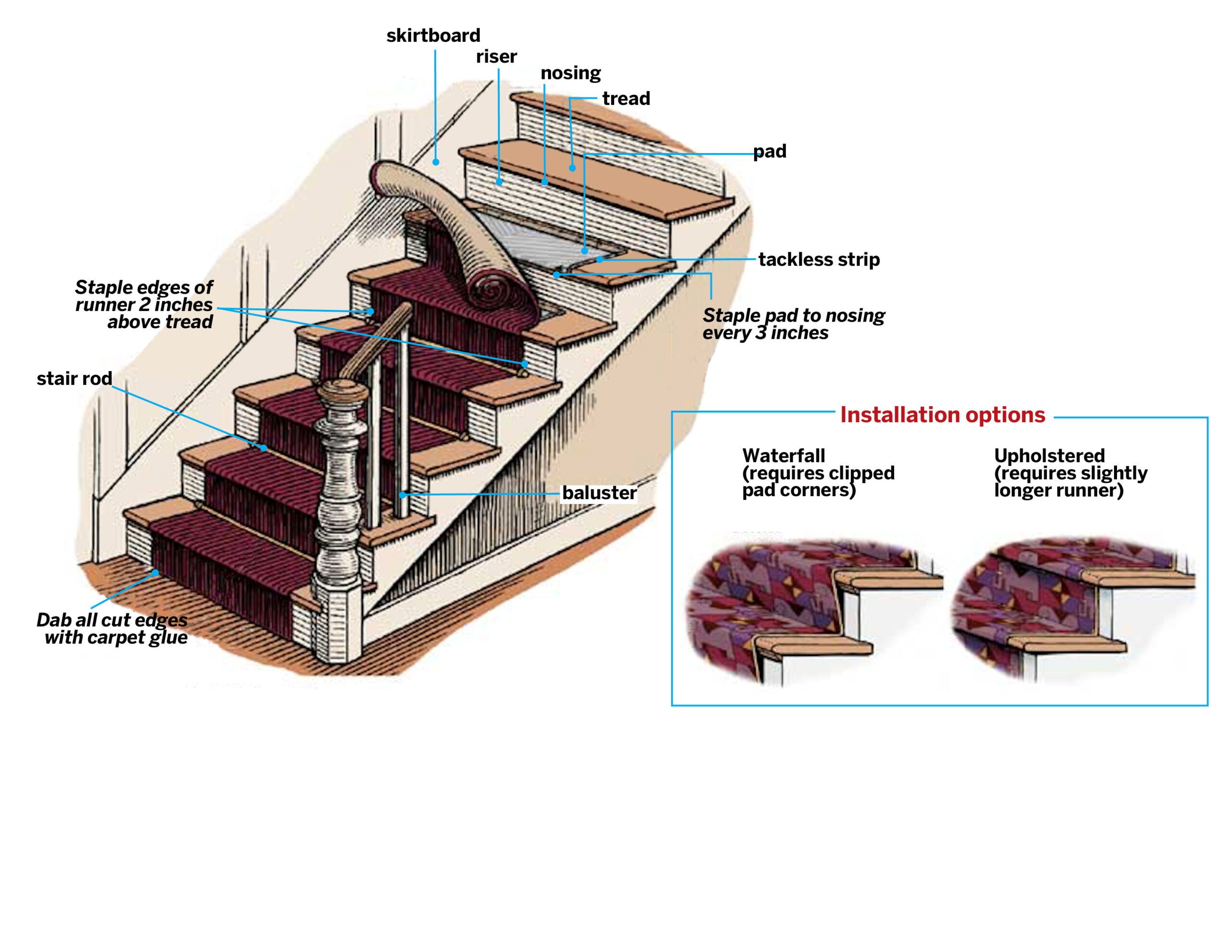
How To Install Stair Rug Runner
Follow these step-by-step instructions to install your stair runner like a pro.
1. Lay Out Tackless Strips for a Stair Runner

- Subtract the runner width from the staircase width (between the baluster and skirtboard) and divide by two.
- On every tread, lightly mark the distance out from the skirtboard and from the balusters where it meets the riser.
- For each tread, use sheet-metal snips to cut a tackless strip 2 inches shorter than the runner width. Be sure there’s a nail within a couple inches of each end.
- Place a scrap piece of strip flush against the riser. Center the cut strip—pins angled toward the riser—between the layout marks. Butt it against the scrap and nail.
2. Fit Carpet Pad
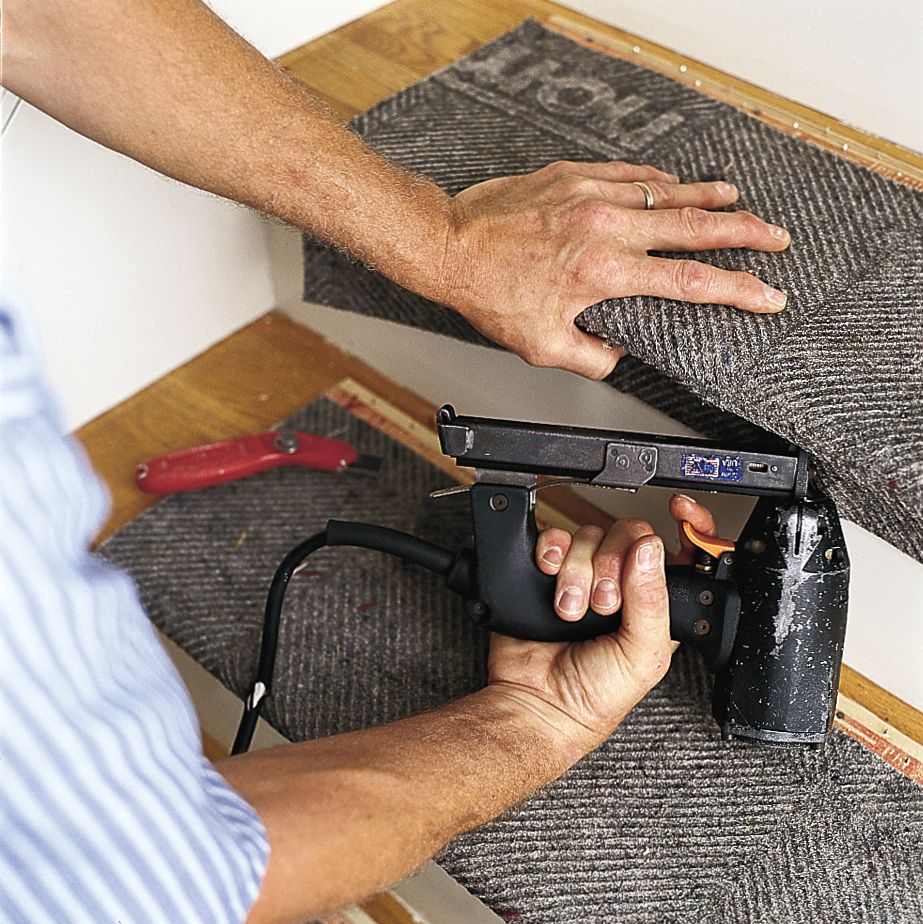
- Cut carpet pad the same width as the tackless strips and 3 inches longer than the depth of the tread.
- Butt pad to front edge of tackless strip. Fasten edge of pad to tread with 9⁄16-inch staples spaced every 3 inches.
- Pull pad tight around nosing and staple every 3 inches into underside of nosing.
- Cut pad where nosing and top of riser meet.
Tip: When using the waterfall method, clip 3 inches off the corners of the pad where it curves around the nosing. This helps hide the pad.
3. Secure Runner to First Riser
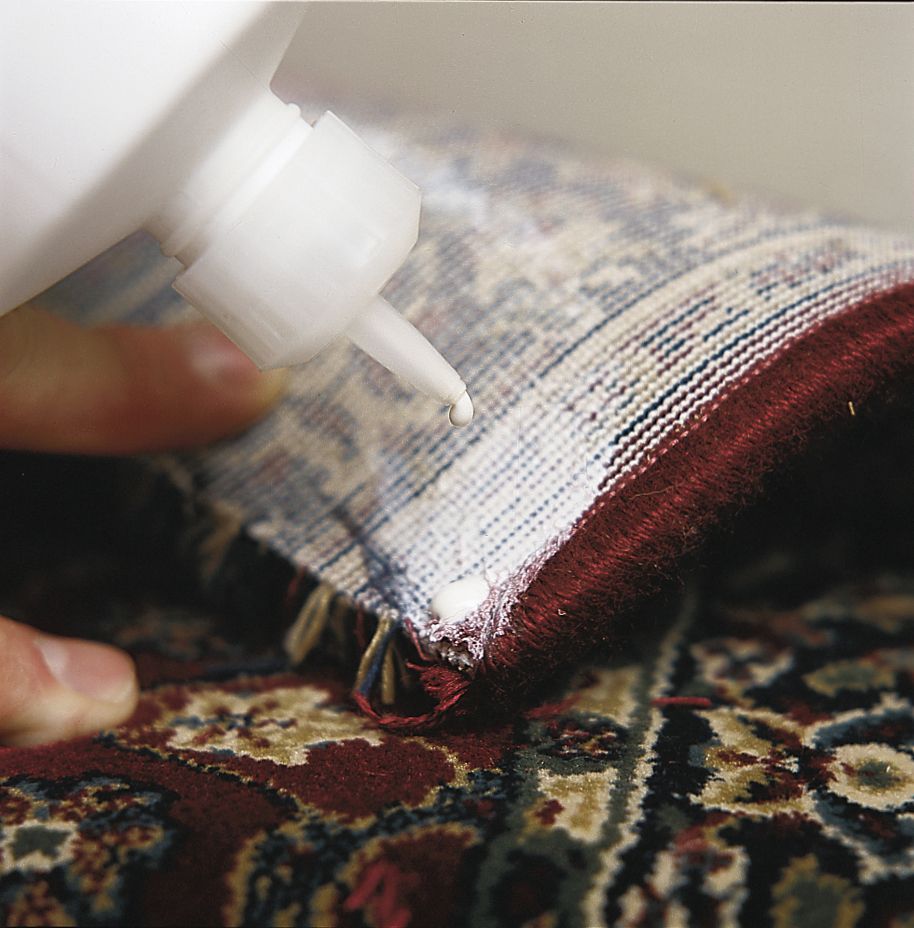
- Check end of runner with framing square. If not square, mark, then cut along backing with carpet knife. Dab cut edges with latex carpet glue to prevent fraying.
- After glue dries to touch, unroll runner up 3 or 4 treads, making sure it’s between the layout marks.
- Push end of runner against floor at bottom of first riser. Line up runner between the layout marks.
- Staple end of runner to bottom of riser every 3 inches.
Tip: Push stapler through the pile and against the backing before pulling trigger.
4. Attach Runner to Treads
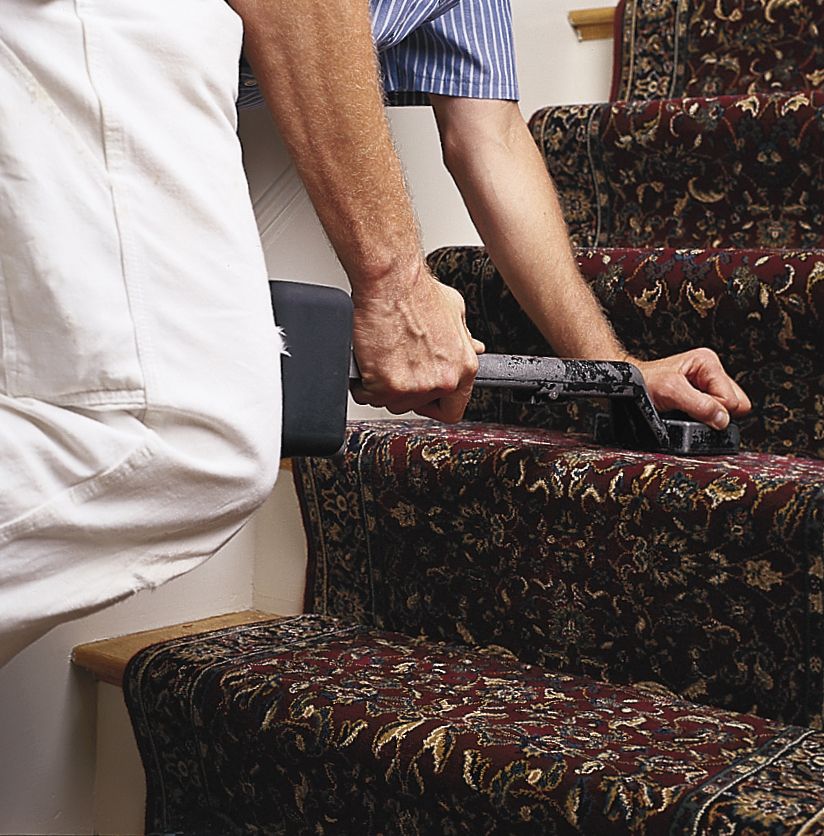
- Line up runner between layout marks on first tread. Push it hand-tight toward tackless strip.
- Place front edge of knee kicker on center of the runner about 2 inches from the riser. Hold down front knob with one hand, using the other hand to keep the kicker’s shaft level.
- Hit kicker with knee. Runner should engage tackless strip and become taut. Repeat every 3 inches, side to side.
Tip: If runner bulges and doesn’t lie flat against the tread, lift it straight up off the strip and begin again.
5. Fasten Runner to Riser
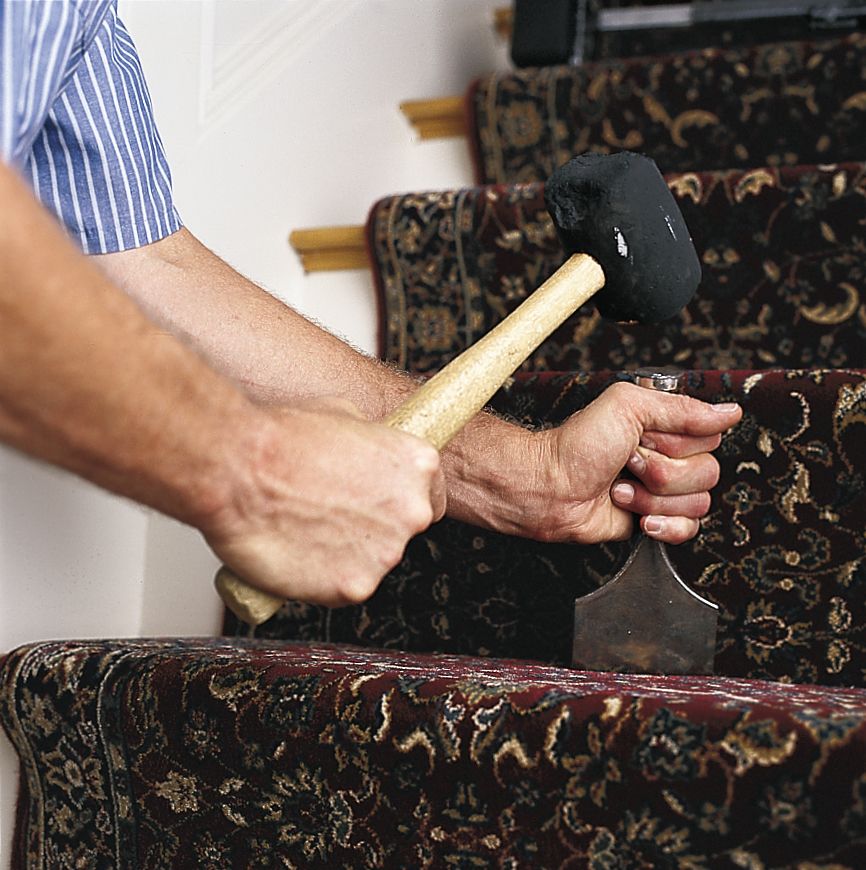
- Use carpet tool and rubber mallet to pack runner tightly between the tackless strip and the riser.
- Near both ends of the tackless strip, staple the runner into the crease where riser meets tread.
- Staple each edge of the runner 2 inches above bottom of riser. (For upholstered installation, staple edges to riser, then staple runner to underside of nosing every 3 inches.)
- Repeat Steps 3 and 4 up to last riser.
- At top of last riser, cut runner tight to the underside of the nosing or molding. Dab edges and end with glue and staple into top of riser and along edges every 3 inches.
Tip: Staple carpet directly to stairs, never through the pad.
6. Install Rods (optional)
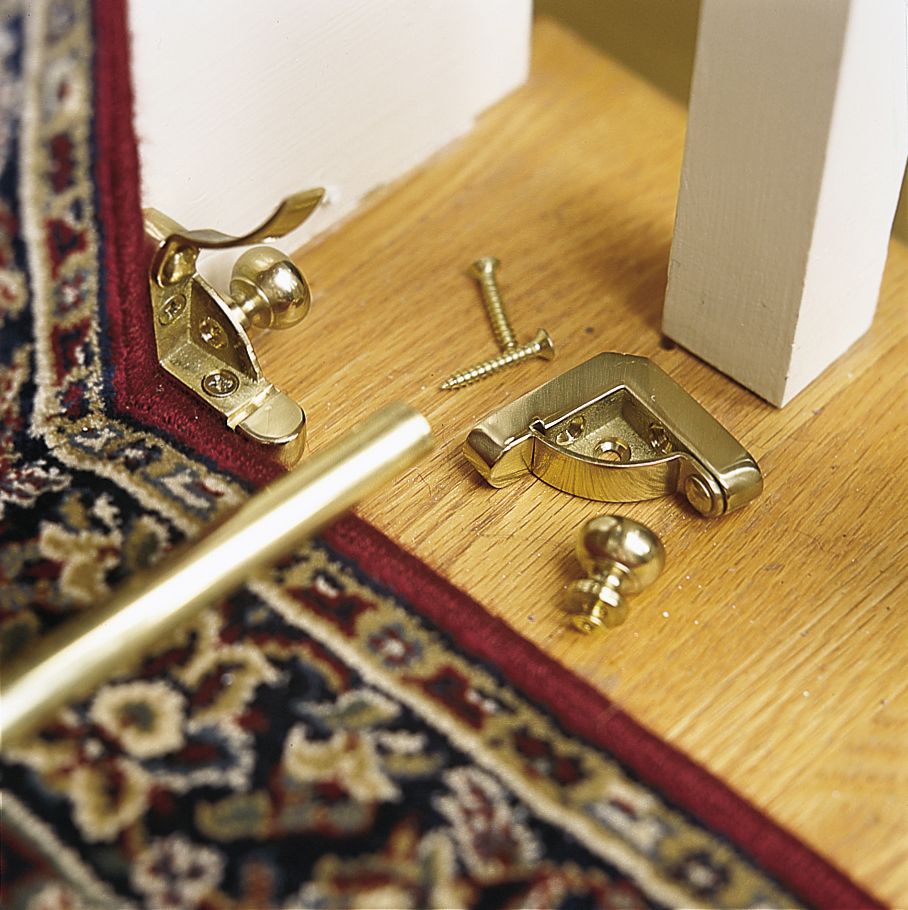
- Attach finials (if any) to outside of each rod bracket.
- Place a bracket against either edge of the runner at the intersection of the tread and riser.
- Hold them in place and mark the locations of the screw holes. Drill 1⁄16-inch pilot holes at each mark.
- Screw each bracket to tread and riser.
- Mark and cut rods to length with a tubing cutter or hacksaw.
- Press rod into crease where tread and riser meet. Secure both ends in the brackets.
Finishing Touches
Complete the installation with these final steps:
- At the bottom of the stairs, create a hem by folding under the runner’s edge.
- Staple the hem to the bottom riser or just above any existing molding.
- Trim any excess material for a clean finish.
Stair Runner Maintenance and Care
Good upkeep will extend the life of your stair runner and keep it looking its best.
Regular Cleaning
Keep your stair runner in good shape with these tips:
- Spot clean spills immediately to prevent staining
- Use a carpet cleaner annually for deep cleaning
- Vacuum regularly to remove dirt and debris
Addressing Wear and Tear
Over time, your runner may show signs of wear. We suggest doing the following:
- Consider getting it professionally cleaned for stubborn stains or an overall refresh
- Repair any loose sections quickly to prevent further damage
- Rotate the runner every so often to distribute wear evenly
Addressing Common Stair Runner Challenges
Even with careful planning, you might encounter a few hiccups. Here’s how to tackle common issues:
Misalignment and Wrinkles
Misalignment and wrinkles can affect your stair runner’s appearance. Fix it with these steps:
- If wrinkles form, gently lift and restretch the runner before securing it.
- Pull the runner taut as you staple, keeping it centered.
Difficult Angles
Stairs with difficult angles or unusual shapes require special attention. Here are some tips:
- Measure and cut the runner to fit tricky spots, creating a seamless look.
- Use additional padding to fill gaps and create a smooth surface.
Seams
Creating a seamless appearance when joining sections is key to your stair runner looking professional. Take these steps:
- Align patterns carefully to keep everything consistent.
- Use carpet glue or seam tape to secure the joins.
Additional Tips for a Professional Finish
A few extra tips can help you achieve a polished look. Try the following:
- Ensure staples are evenly spaced for a uniform finish.
- Trim any frayed edges for a clean appearance.
- Use a knee kicker to keep the runner tight.
Tools
 Knee kicker
Knee kicker Pneumatic stapler
Pneumatic stapler Carpet knife
Carpet knife Carpet tool
Carpet tool Rubber mallet
Rubber mallet Tin snips
Tin snips Tape measure
Tape measure Tubing cutter
Tubing cutter







